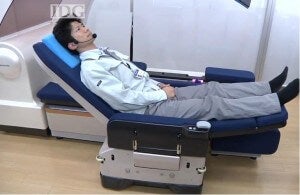
As populations age in industrialized countries all over the world, the elderly may turn to robots to help them with chores and mobility. Panasonic recently held a press conference in Kadoma, Osaka to demonstrate some of their new robotic systems aimed at home use, and assisting the elderly. These devices include a kitchen arm, a motorized lifter/mover, and a bed that turns into a wheelchair. The electronics giant announced that it wanted to reach 100 billion yen (~$1.1 billion USD) in robot sales in 2015/2016, thus becoming profitable in the field at that point. By focusing on assistance bots rather than humanoid machines, Panasonic hopes to build devices which have a ready consumer base. Stocks (TYO:6752) rose briefly on the news. Check out the cool video from IDG and Newtork World.TV after the break.
Japan, like the United States and most other nations in the West, faces increasing healthcare expenses as a large post war generation continues to age. There will certainly be automated systems that will augment the care provided by doctors, nurses, and other professionals. Improved monitoring devices, and various remote controlled probes will increase the efficiency of medical teams. Just as important, we may see an increase in technologies that allow patients to help themselves such as reliable online medical information. Assistance robots would allow you to direct your own care to some extent, or at least manage the day to day tasks that would normally require a human caretaker. The elderly could turn to robotics to guarantee a greater sense of freedom and self reliance.
The Panasonic robots are very cool looking but not all of them are really unique in their performances. Kitchen work is well within the capabilities of a Motoman robot or WAM arm, and the motorized wheelchair attachment is certainly nothing new. Having a bed with a TV that transforms into a chair…now that is pretty amazing, I have to admit. I can see how that could greatly assist a bedridden individual with their mobility and quality of life. Eventually, Panasonic says that it will offer the bed-wheelchair robot for around 1 to 1.5 million yen (more than 11,000 USD) when it eventually hits full scale production.
As the second largest electronics company in the world (sometimes first depending on how Sony is performing) Panasonic is depending on its in-house expertise to give it the edge in producing consumer orientated robots for all age groups. Rechargeable batteries, control interfaces, audio/visual outputs – these things all take time and effort to perfect but Panasonic already has teams formed to address these issues in other products. In the motorized lifter/mover/wheelchair engine, they utilize a pre-existing electric bike motor, cutting down on research and development costs. It will be interesting to see if the Panasonic “we kind of do this stuff already” approach will out perform Honda’s “building robots from the ground up” attitude.
While many of these robots aren’t likely to see distribution until well into the next decade, Panasonic already has plans to start sales on a dispensary robot next year. That bot will provide the correct (pre-determined) medications when a patient’s ID number is supplied. Robots represent a large capital investment for long term savings in labor, so forward looking healthcare providers may act soon to test if the devices will help mitigate the looming aging population crisis. As someone who relishes human contact, I’m not sure if I would feel as comfortable with robotic aides as I would with a living caregiver. Still, as seen with Hanson Robotics, the automatons of the future may be more personable than the silent assistants we see Panasonic developing now. I guess it all depends on whether or not Grandma learns to love the machines.
Screen Capture and Video Credit: IDG and Network World.TV


